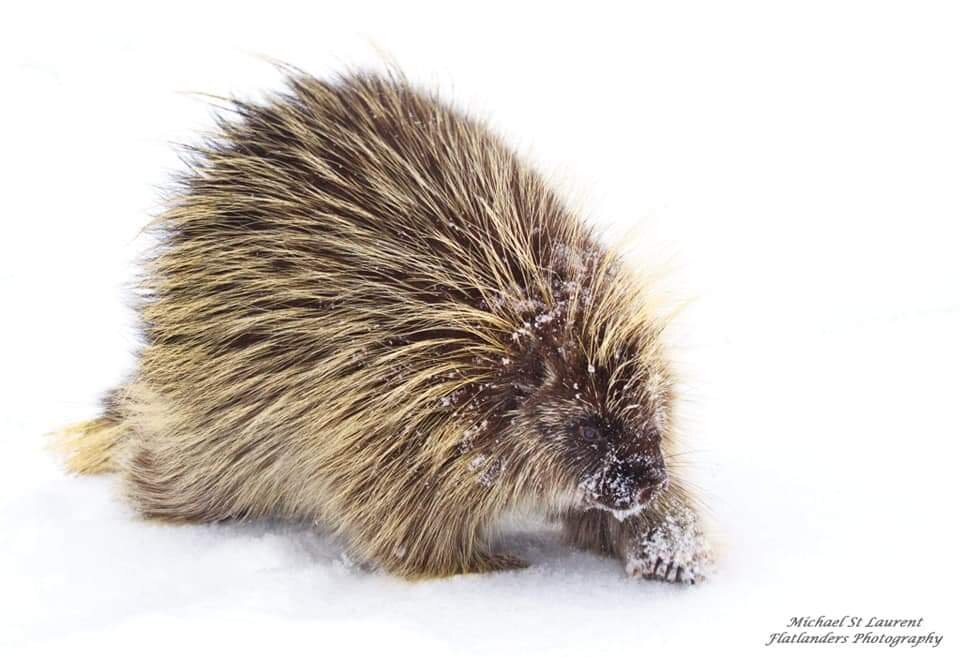Beyond Your Backyard 🍂 The Porcupine - Adapted for Survival
By Kimberly J. Epp
The North American Porcupine is a species many people have seen - but at the same time may not know that much about. For starters, these amazing animals are rodents. In fact, they're the second largest species of rodent in Canada. The beaver is the largest rodent. Another fact that many people may be surprised by is their arboreal lifestyle. We often see them along road sides, but they spend the majority of their life up in the trees.
These rodents are herbivores; feeding on soft twigs, leaves and the bark of trees. You can often tell that a porcupine has been feeding from the pile of half eaten branches below a tree. Willow is a particular favorite, but many tree species can be a source of nutrition. The bark from birch trees is a popular food, and their winter den is usually below a large tree such as this. Similar to beavers, porcupines have rusty orange incisors, due to the secretion that helps to keep them sharp. These incisors keep growing throughout their lifetime, so knawing on the branches and bark keeps them trim.
Porcupine climbing in the willow branches, getting ready to munch down. (Photo by Michael St Laurent)
Most people know porcupines because of one amazing adaptation; their quills! Although some people still believe porcupines can "throw" their quills, they can't. But the quills on their back, known as the rosette, are very long and loosely attached allowing them to easily become embedded in the face of an unsuspecting predator. An adult porcupine can have over 30,000 quills, so it's no surprise that most (but not all) predators leave them alone. A quick whip of their tail can mean hundreds of embedded quills if an animal gets to close.
You can see the guard hairs and the soft under fur on this porcupine. The quills are hidden beneath the guard hairs. (Photo by Michael St. Laurent)
As if that wasn't enough, porcupines can also emit a "cheese" like odor that warns predators of the danger of attacking them. If only our domestic dogs would also heed these warnings!
Because the quills have barbs at the end of them, pulling them out with plyers is very painful for your pet. It is therefore recommended to bring your dog to a vet so it can be put under anesthesia. Many quills get broken and are missed, and end up getting infected. So it is best to just let the vet handle it. Please keep your dog leashed in areas where porcupines reside.
Unlike many rodents, porcupines only produce one young per year. Their gestation period is 210 days. This long development period is caused by the relatively low caloric intake of their diets.
Their young is referred to as a porcupette, and the porcupette's quills harden one hour after birth. If you see a baby alone in a tree, just leave it be. They are often left alone while the mother feeds. Porcupines do not hibernate, and are active all winter. However, they will utilize abandoned burrows and dens from other animals to help stay warm during the cold months. Old beaver bank lodges are popular den sites.
Porcupine out for a stroll in the fresh snow. (Photo by Michael St Laurent)
Although natural deaths such as falls from trees can occur, in most urban areas motor vehicle collisions are the main cause of mortality. Porcupine diets are very low in sodium, so they crave salt. Unfortunately this brings them to roads that have been salted during the winter, a deadly combination.
Porcupines are not endangered, but land converted for agricultural use and increased traffic can locally threaten this species. They are often misunderstood as being pests, while they basically are lone creatures just trying to live their lives.
Porcupines are habitual and territorial. You will never find them far from their winter den. Their trails are followed in the winter by hares, which also nibble on the fallen twigs. Porcupines are not good housekeepers, and basically use their den as a latrine. Occasionally they will push their peanut-shaped scat to the entry.
Pigeon-toed porcupine tracks in freshly fallen snow, with obvious tail drag. Buffalo Pound Provincial Park (Photo by Kimberly Epp)
Porcupines are slow and deliberate, and as long as you give them space and respect, they are easy to observe and photograph. Like any wild animal, they have just as much right to be here as you and I do.
Next time you are out at Wakamow or Buffalo Pound, keep your eye out for the signs they leave behind. And remember to look up, or you may miss one lounging within the branches of a tree!
Don't forget Friday's meeting for the Moose Jaw Nature Society. We meet in the basement of St. Mark's Church at 6:30 pm. The Moose Jaw Wildlife Federation will be speaking about their mobile fish hatchery. Refreshments will be served, and there is no cost to attend.
__________________________________________
Epp is an environmental educator and nature writer and is also the past president and field trip/workshop director for the Moose Jaw Nature Society. She can be reached at kepp@shaw.ca or via the MJNS Facebook page.




